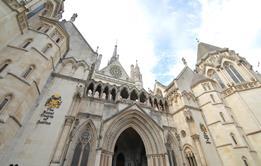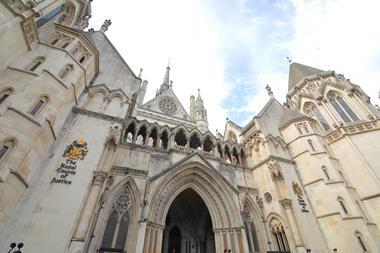A test case brought by the FCA against eight insurers could have significant consequences for insurers, brokers and policyholders. We report on the latest from the High Court…
16.38: The court has adjourned.
16.35: Edelman asked the judges for a rough time frame for the verdict, as people’s lives are depending on the result. Lord Justice Flaux said a draft judgement should be ready by the middle of September, but he said it could be later depending on how long it takes to write the report. He added that he is aware of the importance of the case, so he does not want to take any shortcuts.
16.33: Jones closes her submissions on behalf of the interveners. Due to the shortness of time, Jones and Higgs are invited to submit additional responses in writing by 4pm tomorrow.
16.32: Jones said there must be cover, regardless of the meaning of vicinity.
16.30: RSA rejected cover for each of Radley’s 340 locations, saying that cases in these areas did not contribute to the broader pandemic. Jones disagreed.
16.28: Jones said RSA described SARS as a pandemic. There is no particularity of location, time or manner required in this cover. RSA4 is a composite policy that is broad, it is not an extension.
16.27: Higgs hands over to Jones to make submissions on behalf of RSA4. RSA said it provides cover for events, not continued states of affairs - Jones said this is a convenient shorthand.
16.26: Cases within a mile radius did contribute to the government response, said Higgs.
16.23: Local disease and the national response link discussed by Orr - Higgs asked the judges not to be seduced by accusations that the NHS is different to local hospitals.
16.22: Local cases are not proximate cause - Higgs disagreed. The local outbreak was the proximate cause.
16.20: QBE policies do not envince an intention to preclude cover for a government response to disease or to include cover solely for disease within a proximate area.
16.19: An infectious disease will never be the sole reason for interruption, but it is still within the causal chain, added Higgs. ‘Arising from’ show a causal link.
16.18: The insured peril starts with the interruption, Higgs said. The proximate cause test comes in at the stage between loss and insured peril. They accept that proximate cause must be shown at that stage.
16.16: The QBE policies are combined insurance policies, 16 different heads of cover, insured selects which ones to purchase, BI is typically chosen. In QBE 3, the extensions are optional, many policyholders chose the disease clause. These are not just ‘extensions on extensions’.
16.15: Although there is an exclusion that references interruption related to public authority action, there is not an exclusion specific to this action referring to a notifible disease said Higgs.
16.14: List of perils in one of the exclusions, however human infectious or contagious diseases are not on the list, Higgs said. A notifible disease is notified to the government, this provides a public health response to the spread of disease.
16.12: Additional disease clause - interruption or intereference to the business from human infectious or contagious notifible disease. Due to short time, Higgs is referencing clauses of interest to the judges.
16.10: Higgs is now addressing the QBE wordings for the interveners in Edey QC’s absence.
16.08: Hiscox 1 interveners have all emphasised claim under public authority clause alone, no reference to location, Lynch said. The issue in the case is the proper construction of policy wordings, Lynch explained. Real claims for real policyholders who have real families to support. These are simply claims under simple wordings and correctly construed, the policies should respond. The interveners understand that amounts will be adjusted.
16.07: Lynch said that Hiscox simply stated that the wordings don’t apply, however Lynch added the wordings should be objectively construed.
16.04: Business trends clause - Lynch said the judges are being asked to rule on simple wordings, not causation.
16.02: Occurence meaning and the one mile radius - Lynch addressed the ‘non point’ raised by Gaisman, but Lynch said this impacted 89% of policyholders and is not a non point at all.
16.01: The underlying event need not be local ot specific to the insured, Lynch explained, it is just the impact that has to be local or specific to the insured, which it is.
16.00: Local or specific to the insured - these are specific to the insureds broadly said Lynch. A contagious disease is not likely to be local to the insured. ’The answer is in the clause’ he added.
15.57: The occurence of disease point - difference between ‘occurence’ and ‘outbreak’. Lynch said the clause gives the answer. ‘Infectious’ and ‘contagious’ - means caught by touching someone or something infected. Outbreak envisions both these terms. This is contagious as well as infectious - Legionnaires disease is only infectious so very different. An occurence of a contagious disease is not a single case as someone would always have caught it from someone else. Contagious diseases are very different from infectious diseases - you cannot pinpoint the specific location of a contagious disease, Lynch said. Could be caused by someone passing through.
15.55: Reference to ’shortfall’ is consistent with other clauses, said Lynch. Inability to use can be partial as well, he added. The word ‘interruption’ and ‘inability to use’ should be given their natural and simple meaning. The danger is to put too much pressure on individual words - individually they could mean anything, Lynch said. This is the problem with Hiscox’s argument.
15.53: Interruption means the complete cessation as well as something less, said Lynch. Actual income in indemnity period and the income policyholders would have earned - refers to a ‘reduction’, Lynch said this is consistent with the interpretation that interruption is a cessation or something lesser.
15.50: The meaning of interruption - Gaisman said this means a cessation or stop. Lynch however points out a different section in the wordings that references ‘prevent’ or ‘hinder’ in relation to this clause, so Gaisman’s interpretation is wrong. Lynch said this one example of inconsistencies.
15.48: Ben Lynch QC starts for the interveners (Hiscox). He appeals to the judges to thoroughly read through the full policy wordings, in particular Hiscox policy 1 around business interruption.
15.47: The QCs representing the insurers now highlight to the judges any notes they have in reply to the FCA’s response to their submissions. Most have between one or two pages.
15.42: Edelman concludes his response to submissions.
15.39: What part of the disease is removed and what part of the government restriction, asked Edelman. The insurers would remove the government restrictions only in so far as that it stopped people using their premises. The insures remove the nationwide restrictions and remove none of the disease at all, despite Gaisman’s comments. This is their fundamental approach said Edelman. If they remove the chain, the restrictions on the premises and the disease, what’s left and how will it affect you? This is not their case - they want the nationwide restriction out, but you’ve still got all the disease. That demonstrates how misleading it can be to start slicing up this clause into sections and having the quantification of loss to individual elements.
15.37: Inconsistency in the insurers’ approach to counterfactuals, said Edelman. FCA is not cherry picking, said Edelman. The disease causes the public authority action.
15.35: One point on Ecclesiastical from Edelman - has the liability period come to an end? The authorities relied on by Kealey are very specific and not applicable here, said Edelman, as they are a very different legal context.
15.34: If the government measures are measures that have legal force, implicit or explicit threat, a reasonable observer would think they are captured by this, for example schools that closed, this avoided legal intervention, Edelman added, closing up his responses to Hiscox’s submission. He has nothing to add on Amlin.
15.33: Non-damage denial of access clause - the word ‘incident’. Edelman said this includes the spread of disease into the relavant area, it doesn’t have to be a narrow range matter. The Great Fire of London could be described as an ‘incident’.
15.32: Inability to use - partial use may amount to inability to use, said Edelman. There is an inability to use if the premises cannot be used in the manner it is intended to be used, for example, as a functioning business.
15.29: They can’t get it in through the ‘back door’ with the word ‘occurance’, said Edelman. Outbreak is described as a sudden occurance, said Lord Justice Flaux. Clearly the definitions are different. An occurance could be a cluster, lots of clusters, it could be an outbreak, explained Edelman. It is a flexible term when used to describe disease, he added. It has a range of possible things that might happen.
15.29: The court resumes following a short break.
14.42: Back with Colin Edelman on RSA
14.30: Instructing people not to go somewhere prevents access, Mulcahy contends on Zurich’s policy
14.28: Food shops may be the least affected shop type, but they were still subject to prevention of access, Mulcahy argues when challenged by the judge
14.25: There are no shops that only sell essential items - Mulcahy
14.22: We say there is a fundamental change to your business if you have to change how your business operates, she adds
14.21: Saying prevention must be total, it is implying the policy is a catastrophe policy only - Mulcahy
14.19: That a restaurant that could provide a takeaway service and be regarded as not being interrupted would be met by incredulityby these businesses, Mulcahy states, referring to Arch’s defence
14.17: Not a sensible commercial approach by Arch to say that premises were able to be accessed, says FCA’s Mulcahy QC
14.05: The 25-mile radius clause protects from the insurer from a disease breakout, says FCA QC Edelman. That’s how insurers protect themselves
14.00: And we’re back
13.05 The court is taking a short break and will resume in an hour
13.00 Hiscox has a specific business trends clause, the question is whether the income in the financial year has been adjusted to take out the emerging peril, Edelman highlights a difference in the trends clause.
12.45 Flaux reiterates Edelman’s point of the ’but for’ test, that no case operates this apart from the Orient Express case
12.36 Edelman questions whether the answer to Silversea proximate cause.
12.25 Back to the closure of the church as an example, collections dropped off due to closure, Edelman says that there are two reasons people cannot attend the church so the purpose of the closure of the church was to stop people going back to normal behaviour.
12.21 Speaking about Silversea, if there was already a signalling problem what happens with the landslip, Edelman, but insurers pose the question if an hour before the landslips that the signals were knocked out, what happens then?
12.14 How do you deal with interlinked factors? Asks Edelman. Speaking about 9/11, the suffering of the loss was the trigger but the loss itself has to be quantified. Sometimes one has to look at the nature of the risk to find the inferred intention of the parties might have been.
12.08 Edelman questions an insurer agreeing to pay on storm signals but not on a landlsip when both were insured
11.59 What is business interruption? It is not an insured peril Edelman says, it is merely adding onto damage cover a loss of profit cover.
11.52 Edelman debates an example where two risks are insured using a landslip example, he questions why it makes a difference where only one is covered. When insurers are insuring a landslip, when a landslip occurs is when there is exceptional rainfall
11.44 Back to the trends clause, Edelman says it deals with quantification and that it does not address proximate cause. But in the case of two sets of insuring clauses are being used, it would be a breach of contract not to provide indemnity under one of them. If neither of them satisfy the ‘but for’ test where it doesn’t make sense, he uses an example of a hotel being insured in the event of a hurricane
11.38 Flaux says the the obvious question to be asked in context of insurance law is “what is being relied upon the proximate cause of the loss?” Edelman adds in it should be proximate and effective cause.
11.06: But Edelman says that the presence of a 25 mile radius demonstrates that insurers are contemplaction larger outbreaks that could cover a sizeable distance, not just single instances of a disease
11.00: Lord Justice Flaux says he has ‘much more difficulty’ in seeing how if a national outbreak is one indivisable clause, how that could trigger a policy with a relevant policy area
10.42: Edelman says insurers are trying to use a but for test as a filter
10.30: A but for test in a trends clause has ’absolutely nothing whatsoever to tell you about whether the proximate cause requirement is satisfied for a trigger’
10.20: Edelman now refers to SAGE meeting minutes as evidence that the UK government used this data to monitor the progression of the disease across the country
10.18: Edelman draws the courts attention to the Covid-19 reported cases data available online and in spreadsheet format
10.14: For this policies with a relevent policy area, Edelman says the FCA’s jigsaw argument ‘is the answer’
10.08: Edelman argues that this case has a multitude of contributory causes with a national picture, none of which have ‘less causative efficacy’
10.04: The FCA argues that having a snap finger but for test before determining if a policy has been triggered is legally wrong, Edelman says, arguing that insurers are wrongly jumping on the Orient Express ‘band wagon’
10.03: Edelman argues that insurers are just using the but for test to ‘knock us out’, but Lord Justice Flaux says the insurers’ cases went further than that to say occurrence of the disease and the location is the proximate cause of the loss
10.02: Edelman says the but for test is useful for quantification, but is a different question to the primary issue of proximate cause
10.01: Lord Justice Flaux asks what ‘all this the but for analysis is really about’
10.00: Welcome to Day 8 of the test case. We are now back to Colin Edelman QC on behalf of the FCA
Missed yesterday’s proceedings? You can catch up on all the action from the seventh day of the hearing here
Read more…
Not subscribed? Become a subscriber and access our premium content

Hosted by comedian and actor Tom Allen, 34 Gold, 23 Silver and 22 Bronze awards were handed out across an amazing 34 categories recognising brilliance and innovation right across the breadth of UK general insurance.
FCA business interruption test case

- 1
- 2
- 3
- 4
- 5
- 6
- 7
 Currently
reading
Currently
reading
FCA business interruption test case: Day 8 - as it happened




































































No comments yet